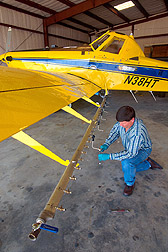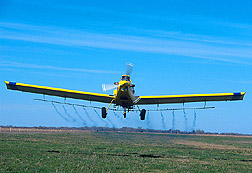New Products To Suppress an Old Insect Pest
|
||
|
|
In Wharton County, Texas, some corn farmers say they must control Mexican corn rootworms—the predominant pest of corn in their area—or get out of farming. To alleviate their woes, farmers participating in an areawide integrated pest management (IPM) project to control corn rootworms are getting a helping hand from ARS agricultural engineer W. Clint Hoffmann and others in the Areawide Pest Management Research Unit at College Station, Texas.
"Rootworms drive up the cost of farming in the Corn Belt and in Texas, which ranks seventh in corn production. Almost every acre of corn in Texas is treated with soil insecticides at planting to limit root damage caused by rootworm larvae. These soil treatments are expensive—ranging from $10 to $15 an acre—environmentally unfriendly, and sometimes ineffective at stopping rootworm infestation," says Hoffmann. Soil insecticides are among the most toxic agricultural chemicals, and they reduce adult rootworm emergence by only 40 to 50 percent, according to ARS entomologist Dale W. Spurgeon. Several new adult-control products have been developed that use lower doses of toxicants. The Texas researchers showed that with proper timing and application methods, these products can cut corn-rootworm damage while having little or no harmful effect on the environment. |
|
|
Slamming the Corn Rootworm
In 1995, working closely with farmers, extension personnel, and industry, Hoffmann and ARS agricultural engineer Ivan W. Kirk and other scientists at College Station began an adult rootworm control program using aerial applications of Slam. Made by MicroFlo, Inc., in Lakeland, Florida, Slam is based on research by ARS entomologist Gerald Sutter in Brookings, South Dakota. A combination of a feeding stimulant derived from wild buffalo gourd root and the insecticide carbaryl, Slam reduced the number of rootworm-infested acres from 2,000 to 80 in the test area over 3 years with a carbaryl application rate of just 1 ounce per acre. Carbaryl is normally applied at 2 to 3 pounds per acre. "Just as important, farmers in the management area cut their use of soil insecticides in half. Farmers will still use some soil insecticides to control other soil insects. But this was our first victory with a product using a low dose of toxicant to control adult beetles," says Hoffmann. Because the western corn rootworm has developed resistance to carbaryl, making it particularly difficult to control in Nebraska, two other companies have launched new products that allow farmers to use one-tenth the labeled rate of any other toxicant labeled for corn—CideTrak (see sidebar) and Invite. ARS entomologist Robert F.W. Schroder, of the Insect Biocontrol Laboratory in Beltsville, Maryland, concocted Invite by using Hawksberry watermelon juice as the feeding stimulant. The active ingredient in Invite is water soluble, according to Schroder. Invite is made by FFP AgroTech, Inc., in Eustis, Florida. Recent performance trials in Granger, Texas, of CideTrak and Invite—each combined with several different types of toxicants—showed effective rootworm control, according to Hoffmann. Baits and Traps Knowing when to apply insecticides is essential to any insect-control program. To take the guesswork out of timing spray applications, Trécé designed a trap with a kairomone—a scent that mimics the adult beetle's favorite food. The plastic dome-shaped trap looks somewhat like an ice cream sundae container. The traps are placed 30 feet inside the cornfield. Twenty years ago, managing corn rootworms was simple: just rotate crops from corn to soybeans. "Now, we're finding new corn rootworm strains laying their eggs in blooming soybeans and sorghum. Traps help us determine when adult treatments are needed so we can prevent that from happening," says Spurgeon. Another Threat: Aflatoxin Besides corn rootworms, yet another daunting foe of corn growers in this management area is aflatoxin, which affects food safety and corn prices. Could there be a connection between the number of beetles and the incidence of aflatoxin? ARS palynologist (one who studies pollen) Gretchen D. Jones thinks there is. "In 1998, the scientists found 50 percent less aflatoxin in the area with low numbers of adult rootworms than in the untreated areas," she says. To confirm this phenomenon, Jones covers individual corn plants with insect-proof bags, ensuring that no insects or pollen can enter. Soon afterward she pollinates the plants using aflatoxin-free pollen. Once it's known whether or not the Mexican corn rootworm spreads aflatoxin to corn, farmers will have one more reason to control the insects over a large area. The Areawide Corn Rootworm Management program is one of several national areawide IPM programs driven by USDA's commitment to reduce reliance on agricultural chemicals. The nationwide programs, which also include control of codling moths, leafy spurge, and stored-grain insects, began in 1994.—By Linda McGraw, Agricultural Research Service Information Staff. This research is part of Crop Production, an ARS National Program (#305) described on the World Wide Web at http://www.nps.ars.usda.gov. To reach the scientists mentioned in this article, contact Linda McGraw, USDA-ARS National Center for Agricultural Utilization Research, Information Staff, 1815 N. University Street, Peoria, IL 61604; phone (309) 681-6530, fax (309) 681-6690. Chemical Insecticide Use Gets CideTrak'ed Research that improved microbial insecticide formulations also led to environmentally friendly chemical formulations. Before some crops were genetically transformed to resist certain insects, scientists at the ARS National Center for Agricultural Utilization Research and the Biotechnology Research and Development Corp., Peoria, Illinois, wanted to solve a bugaboo of spray-applied biological control agents: If rain didn't wash away caterpillar-killing viruses and bacteria soon after they were sprayed on the plants, the harsh sun would likely deal these beneficial microbes a quick, untimely death. "The remedy on both counts turned out to be a new spray formulation that included the sticky protein wheat gluten, made soluble by a chemical such as citric acid," said ARS entomologist Michael R. McGuire. When spray droplets dry on leaves, they stick like glue. The gluten also shields the helpful microbes from the sun's lethal ultraviolet rays. A patent was issued in 1996. In 1999, Bill Lingren, president of Trécé, Inc., was seeking technology that would help the company develop crop-protection formulations that would include a feeding stimulant along with any of several insecticides. By rotating use of these agrichemicals, farmers could help ensure that insecticide-resistant strains of corn rootworms would not quickly develop in their fields. In a cooperative research and development agreement (CRADA) between ARS and Trécé, the sticky wheat-gluten-based formulations again proved useful. The company licensed the invention and now markets it under the name CideTrak. When combined with any of at least three types of insecticides—pyrethroids, carbamates, and organophosphates—at one-tenth the normal rates of application, CideTrak has worked better than conventional sprays, says Scott Lingren, Trécé's global field development manager. The partners have extended the CRADA into 2001 as they test CideTrak's potential when combined with other insecticides.—By Ben Hardin, Agricultural Research Service Information Staff. The research is part of New Uses, Quality, and Marketability of Plant and Animal Products, an ARS National Program (#306) described on the World Wide Web at http://www.nps.ars.usda.gov. Michael R. McGuire, formerly at the USDA-ARS National Center for Agricultural Utilization Research, Peoria, IL, is now in the USDA-ARS Western Integrated Cropping Systems Research Unit, 17053 Shafter Ave., Shafter, CA 93263; phone (805) 746-8001, fax (805) 746-1619. |
|
|
"New Products To Suppress an Old Insect Pest" was published in the November 2000 issue of Agricultural Research magazine. |
||








